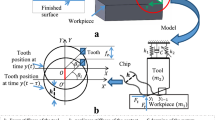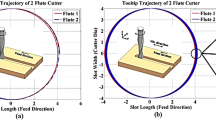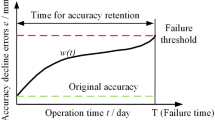Abstract
In longitudinal vibration-assisted milling (LVAM), the tool flute is retracted from the bottom of the machined surface along the axial/longitudinal direction. Nevertheless, there is still a limitation in the knowledge of LVAM during Ti-6Al-4 V cutting regarding the cutting forces pattern in analysis using finite element (FE) simulations and analytical prediction comparatively. This study developed an FE model of the cutting force using ABAQUS and a mathematical model of the cutting force using MATLAB. The FE model was developed based on the Johnson–Cook plastic deformation and the Johnson–Cook damage model. The analytical prediction was developed based on the fluctuated undeformed axial chip thickness and the influence of the longitudinal vibration on the undeformed chip thickness. According to this comparative study, the analytical prediction of the cutting force coded in MATLAB has remarkable similarity with the FE simulation model cutting force. The experimental cutting forces were also carried out to validate both the FE simulation model and the mathematical model. According to the comparison results in the LVAM, the FE simulation model has higher quantitative error than that in the mathematical model, with the highest error in the mathematical model being about 7.146% and the highest error in the numerical model being about 9.913%. In addition, a comparative study between LVAM and CM in terms of the experimental cutting temperature, machined surface morphology, and chip morphology was also carried out. In evidence, LVAM provides better machining performance than CM.



























Similar content being viewed by others
Data availability
The availability of data and materials are available in supplementary materials.
Code availability
The code is available in supplementary materials.
References
Jangali Satish G, Gaitonde VN, Kulkarni VN (2021) Traditional and non-traditional machining of nickel-based superalloys: a brief review. Mater Today Proc 44:1448–1454. https://doi.org/10.1016/j.matpr.2020.11.632
Asmael M, Safaei B, Zeeshan Q et al (2021) Ultrasonic machining of carbon fiber–reinforced plastic composites: a review. Int J Adv Manuf Technol 113:3079–3120. https://doi.org/10.1007/s00170-021-06722-2
Wu C, Cao S, Zhao YJ et al (2021) Preheating assisted wire EDM of semi-conductive CFRPs: principle and anisotropy. J Mater Process Technol 288:116915. https://doi.org/10.1016/j.jmatprotec.2020.116915
Sun Y, Jin L, Gong Y et al (2022) Experimental evaluation of surface generation and force time-varying characteristics of curvilinear grooved micro end mills fabricated by EDM. J Manuf Process 73:799–814. https://doi.org/10.1016/j.jmapro.2021.11.049
Gobikrishnan U, Suresh P, Kumaravel P (2020) Drilling investigations on Inconel alloy 625 material of material removal rate using micro electrochemical machining. Mater Today Proc 37:1629–1633. https://doi.org/10.1016/j.matpr.2020.07.173
Arefin S, Zhang XQ, Kumar AS et al (2021) Study of chip formation mechanism in one-dimensional vibration-assisted machining. J Mater Process Technol 291:117022. https://doi.org/10.1016/j.jmatprotec.2020.117022
Parida AK, Maity K (2021) Study of machinability in heat-assisted machining of nickel-base alloy. Meas J Int Meas Confed 170:108682. https://doi.org/10.1016/j.measurement.2020.108682
Teti R, D’Addona DM, Segreto T (2021) Microbial-based cutting fluids as bio-integration manufacturing solution for green and sustainable machining. CIRP J Manuf Sci Technol 32:16–25. https://doi.org/10.1016/j.cirpj.2020.09.016
Khatir FA, Sadeghi MH, Akar S (2022) Investigation of surface integrity in laser-assisted turning of AISI 4340 hardened steel: finite element simulation with experimental verification. Opt Laser Technol 147:107623. https://doi.org/10.1016/j.optlastec.2021.107623
Brehl D, Dow T (2008) Review of vibration-assisted machining. Precis Eng 32:153–172. https://doi.org/10.1016/j.precisioneng.2007.08.003
Lotfi M, Akbari J (2021) Finite element simulation of ultrasonic-assisted machining: a review. Int J Adv Manuf Technol 116:2777–2796. https://doi.org/10.1007/s00170-021-07205-0
Zhang X, Shivpuri R, Srivastava AK (2015) Role of tool flank wear and machining speed in developing of residual stress in machined surface during high speed machining of titanium alloys. ASME 2015 Int Manuf Sci Eng Conf MSEC 2015 1:1–9. https://doi.org/10.1115/MSEC20159401
Ulutan D, Ozel T (2011) Machining induced surface integrity in titanium and nickel alloys: a review. Int J Mach Tools Manuf 51:250–280. https://doi.org/10.1016/j.ijmachtools.2010.11.003
Yang Z, Zhu L, Zhang G et al (2020) Review of ultrasonic vibration-assisted machining in advanced materials. Int J Mach Tools Manuf 156:103594. https://doi.org/10.1016/j.ijmachtools.2020.103594
Zheng L, Chen W, Huo D (2020) Review of vibration devices for vibration-assisted machining. Int J Adv Manuf Technol 108:1631–1651. https://doi.org/10.1007/s00170-020-05483-8
Shen XH, Zhang JH, Li H et al (2012) Ultrasonic vibration-assisted milling of aluminum alloy. Int J Adv Manuf Technol 63:41–49. https://doi.org/10.1007/s00170-011-3882-5
Shen XH, Zhang J, Xing DX, Zhao Y (2012) A study of surface roughness variation in ultrasonic vibration-assisted milling. Int J Adv Manuf Technol 58:553–561. https://doi.org/10.1007/s00170-011-3399-y
Tao G, Ma C, Shen X, Zhang J (2017) Experimental and modeling study on cutting forces of feed direction ultrasonic vibration-assisted milling. Int J Adv Manuf Technol 90:709–715. https://doi.org/10.1007/s00170-016-9421-7
Zhang Y, Zhao B, Wang Y, Chen F (2017) Effect of machining parameters on the stability of separated and unseparated ultrasonic vibration of feed direction assisted milling. J Mech Sci Technol 31:851–858. https://doi.org/10.1007/s12206-017-0137-x
Feng Y, Hsu FC, Lu YT et al (2020) Force prediction in ultrasonic vibration-assisted milling. Mach Sci Technol 25:307–330. https://doi.org/10.1080/10910344.2020.1815048
Xu LH, Na HB, Han GC (2018) Machinablity improvement with ultrasonic vibration–assisted micro-milling. Adv Mech Eng 10:1–12. https://doi.org/10.1177/1687814018812531
Liu X, Wang W, Jiang R et al (2020) Investigation on surface roughness in axial ultrasonic vibration–assisted milling of in situ TiB2/7050Al MMCs. Int J Adv Manuf Technol 111:63–75. https://doi.org/10.1007/s00170-020-06081-4
Liu XF, Wang WH, Jiang RS et al (2020) Tool wear mechanisms in axial ultrasonic vibration assisted milling in-situ TiB2/7050Al metal matrix composites. Adv Manuf 8:252–264. https://doi.org/10.1007/s40436-020-00294-2
Verma GC, Pandey PM (2019) Machining forces in ultrasonic-vibration assisted end milling. Ultrasonics 94:350–363. https://doi.org/10.1016/j.ultras.2018.07.004
Wang H, Zhang S, Li G (2022) Experimental Study on Ultrasonic-Assisted End Milling Forces in 2195 Aluminum-Lithium Alloy. Materials (Basel) 15:2508. https://doi.org/10.3390/ma15072508
Liu J, Chen G, Ren C et al (2020) Effects of axial and longitudinal-torsional vibration on fiber removal in ultrasonic vibration helical milling of CFRP composites. J Manuf Process 58:868–883. https://doi.org/10.1016/j.jmapro.2020.08.071
Xing D, Zhang J, Shen X et al (2013) Tribological properties of ultrasonic vibration assisted milling aluminium alloy surfaces. Procedia CIRP 6:539–544. https://doi.org/10.1016/j.procir.2013.03.008
Chen W, Huo D, Shi Y, Hale JM (2018) State-of-the-art review on vibration-assisted milling: principle, system design, and application. Int J Adv Manuf Technol 97:2033–2049. https://doi.org/10.1007/s00170-018-2073-z
Janghorbanian J, Razfar MR, Zarchi MMA (2013) Effect of cutting speed on tool life in ultrasonic-assisted milling process. Proc Inst Mech Eng Part B J Eng Manuf 227:1157–1164. https://doi.org/10.1177/0954405413483722
Li KM, Wang SL (2014) Effect of tool wear in ultrasonic vibration-assisted micro-milling. Proc Inst Mech Eng Part B J Eng Manuf 228:847–855. https://doi.org/10.1177/0954405413510514
Liu Y, Liu Z, Wang X, Huang T (2020) Experimental study on tool wear in ultrasonic vibration–assisted milling of C/SiC composites. Int J Adv Manuf Technol 107:425–436. https://doi.org/10.1007/s00170-020-05060-z
Ni C, Zhu L, Yang Z (2019) Comparative investigation of tool wear mechanism and corresponding machined surface characterization in feed-direction ultrasonic vibration assisted milling of Ti–6Al–4V from dynamic view. Wear 436–437:203006. https://doi.org/10.1016/j.wear.2019.203006
Chen W, Zheng L, Huo D, Chen Y (2018) Surface texture formation by non-resonant vibration assisted micro milling. J Micromech Microeng 28. https://doi.org/10.1088/1361-6439/aaa06f
Zheng L, Chen W, Pozzi M et al (2019) Modulation of surface wettability by vibration assisted milling. Precis Eng 55:179–188. https://doi.org/10.1016/j.precisioneng.2018.09.006
Tao G, Ma C, Bai L et al (2017) Feed-direction ultrasonic vibration−assisted milling surface texture formation. Mater Manuf Process 32:193–198. https://doi.org/10.1080/10426914.2016.1198029
Shimada K, Chen Z, Mizutani M, Kuriyagawa T (2020) Ultrasonic-assisted face milling for fabricating hierarchical microstructures. Int J Autom Technol 14:238–244. https://doi.org/10.20965/ijat.2020.p0238
Gao H, Ma B, Zhu Y, Yang H (2022) Enhancement of machinability and surface quality of Ti-6Al-4V by longitudinal ultrasonic vibration-assisted milling under dry conditions. Meas J Int Meas Confed 187:110324. https://doi.org/10.1016/j.measurement.2021.110324
Ni C, Zhu L, Liu C, Yang Z (2018) Analytical modeling of tool-workpiece contact rate and experimental study in ultrasonic vibration-assisted milling of Ti–6Al–4V. Int J Mech Sci 142–143:97–111. https://doi.org/10.1016/j.ijmecsci.2018.04.037
Chen W, Huo D, Hale J, Ding H (2018) Kinematics and tool-workpiece separation analysis of vibration assisted milling. Int J Mech Sci 136:169–178. https://doi.org/10.1016/j.ijmecsci.2017.12.037
Verma GC, Pandey PM, Dixit US (2018) Modeling of static machining force in axial ultrasonic-vibration assisted milling considering acoustic softening. Int J Mech Sci 136:1–16. https://doi.org/10.1016/j.ijmecsci.2017.11.048
Liu X, Wang W, Jiang R et al (2021) Analytical model of workpiece temperature in axial ultrasonic vibration-assisted milling in situ TiB2/7050Al MMCs. Int J Adv Manuf Technol. https://doi.org/10.1007/s00170-021-08105-z
Liu X, Wang W, Jiang R, Xiong Y (2021) Analytical model of cutting force in axial ultrasonic PRMMCs. Chinese J Aeronaut 34:160–173. https://doi.org/10.1016/j.cja.2020.08.009
Pang Y, Feng P, Wang J et al (2021) Performance analysis of the longitudinal-torsional ultrasonic milling of Ti-6Al-4V. Int J Adv Manuf Technol 113:1255–1266. https://doi.org/10.1007/s00170-021-06682-7
Babitsky VI, Mitrofanov AV, Silberschmidt VV (2004) Ultrasonically assisted turning of aviation materials: simulations and experimental study. Ultrasonics 42:81–86. https://doi.org/10.1016/j.ultras.2004.02.001
Lotfi M, Amini S (2018) Effect of ultrasonic vibration on frictional behavior of tool–chip interface: finite element analysis and experimental study. Proc Inst Mech Eng Part B J Eng Manuf 232:1212–1220. https://doi.org/10.1177/0954405416666895
Kong C, Wang D (2018) Numerical investigation of the performance of elliptical vibration cutting in machining of AISI 1045 steel. Int J Adv Manuf Technol 98:715–727. https://doi.org/10.1007/s00170-018-2277-2
Kurniawan R, Kumaran ST, Ko TJ (2021) Finite Element Analysis in Ultrasonic Elliptical Vibration Cutting (UEVC) During Micro-Grooving in AISI 1045. Int J Precis Eng Manuf. https://doi.org/10.1007/s12541-021-00554-6
Chen W, Zheng L, Teng X et al (2019) Finite element simulation and experimental investigation on cutting mechanism in vibration-assisted micro-milling. Int J Adv Manuf Technol 105:4539–4549. https://doi.org/10.1007/s00170-019-03402-0
Xiang D, Shi Z, Feng H et al (2019) Finite element analysis of ultrasonic assisted milling of SiCp/Al composites. Int J Adv Manuf Technol 105:3477–3488. https://doi.org/10.1007/s00170-019-04542-z
Ying N, Feng J, Bo Z (2020) A novel 3D finite element simulation method for longitudinal-torsional ultrasonic-assisted milling. Int J Adv Manuf Technol 106:385–400. https://doi.org/10.1007/s00170-019-04636-8
Altintas Y (2012) Manufacturing automation metal cutting vibrations and CNC design, 2nd edn. Cambridge University Press, United States
Budak E, Altintaş Y, Armarego EJA (1996) Prediction of milling force coefficients from orthogonal cutting data. J Manuf Sci Eng Trans ASME 118:216–224. https://doi.org/10.1115/1.2831014
Ning J, Liang SY (2018) Model-driven determination of Johnson-Cook material constants using temperature and force measurements. Int J Adv Manuf Technol 97:1053–1060. https://doi.org/10.1007/s00170-018-2022-x
Lee EH, Shaffer BW (1951) The theory of plasticity applied to a problem of machining. J Appl Mech 18:405–413. https://doi.org/10.1115/1.4010357
Özel T, Zeren E (2004) Determination of work material flow stress and friction for FEA of machining using orthogonal cutting tests. J Mater Process Technol 153–154:1019–1025. https://doi.org/10.1016/j.jmatprotec.2004.04.162
Kurniawan R, Ko TJ (2019) Cutting force model in micro-dimple pattern process using two-frequency elliptical vibration texturing (TFEVT) method. Int J Precis Eng Manuf. https://doi.org/10.1007/s12541-019-00035-x
Fang N, Wu Q (2009) A comparative study of the cutting forces in high speed machining of Ti-6Al-4V and Inconel 718 with a round cutting edge tool. J Mater Process Technol 209:4385–4389. https://doi.org/10.1016/j.jmatprotec.2008.10.013
Kurniawan R, Xu M, Li CP et al (2022) Numerical analysis in ultrasonic elliptical vibration cutting (UEVC) combined with electrical discharge assistance (EDA) for Ti6Al4V. Int J Adv Manuf Technol 120:471–498. https://doi.org/10.1007/s00170-022-08724-0
Chen G, Ren C, Yang X et al (2011) Finite element simulation of high-speed machining of titanium alloy (Ti-6Al-4V) based on ductile failure model. Int J Adv Manuf Technol 56:1027–1038. https://doi.org/10.1007/s00170-011-3233-6
Umbrello D (2008) Finite element simulation of conventional and high speed machining of Ti6Al4V alloy. J Mater Process Technol 196:79–87. https://doi.org/10.1016/j.jmatprotec.2007.05.007
Wang B, Liu Z (2015) Shear localization sensitivity analysis for Johnson-Cook constitutive parameters on serrated chips in high speed machining of Ti6Al4V. Simul Model Pract Theory 55:63–76. https://doi.org/10.1016/j.simpat.2015.03.011
Johnson GR, Cook WH (1985) Fracture characteristics of three metals subjected to various strains, strain rates, temperatures and pressures. Eng Fract Mech 21:31–48. https://doi.org/10.1016/0013-7944(85)90052-9
Akram S, Jaffery SHI, Khan M et al (2018) Numerical and experimental investigation of Johnson-Cook material models for aluminum (AL 6061–t6) alloy using orthogonal machining approach. Adv Mech Eng 10:1–14. https://doi.org/10.1177/1687814018797794
Liu Y, Xu D, Agmell M et al (2021) Numerical and experimental investigation of tool geometry effect on residual stresses in orthogonal machining of Inconel 718. Simul Model Pract Theory 106:102187. https://doi.org/10.1016/j.simpat.2020.102187
Chandra Mouli G, Prakash Marimuthu K, Jagadeesha T (2020) 2D Finite Element Analysis of Inconel 718 Under Turning Processes. IOP Conf Ser Mater Sci Eng 912. https://doi.org/10.1088/1757-899X/912/3/032021
Yang J, Sun S, Brandt M, Yan W (2010) Experimental investigation and 3D finite element prediction of the heat affected zone during laser assisted machining of Ti6Al4V alloy. J Mater Process Technol 210:2215–2222. https://doi.org/10.1016/j.jmatprotec.2010.08.007
Ryabov O, Mori K, Kasashima N (1998) Laser displacement meter application for milling diagnostics. Opt Lasers Eng 30:251–263. https://doi.org/10.1016/S0143-8166(98)00032-3
Lamraoui M, Thomas M, El Badaoui M, Girardin F (2014) Indicators for monitoring chatter in milling based on instantaneous angular speeds. Mech Syst Signal Process 44:72–85. https://doi.org/10.1016/j.ymssp.2013.05.002
Shan C, Zhang X, Shen B, Zhang D (2019) An improved analytical model of cutting temperature in orthogonal cutting of Ti6Al4V. Chinese J Aeronaut 32:759–769. https://doi.org/10.1016/j.cja.2018.12.001
Lai X, Li H, Li C et al (2008) Modelling and analysis of micro scale milling considering size effect, micro cutter edge radius and minimum chip thickness. Int J Mach Tools Manuf 48:1–14. https://doi.org/10.1016/j.ijmachtools.2007.08.011
Kurniawan R, Kumaran ST, Ali S et al (2018) Experimental and analytical study of ultrasonic elliptical vibration cutting on AISI 1045 for sustainable machining of round-shaped microgroove pattern. Int J Adv Manuf Technol 98:2031–2055. https://doi.org/10.1007/s00170-018-2359-1
Funding
This research was supported by the Basic Science Research Program through the National Research Foundation of Korea (NRF) funded by the Ministry of Science, ICT, and Future Planning (grant number NRF-2020R1A2B5B02001755). Also, this research was supported by Korea Electrotechnology Research Institute (KERI) primary research program through the National Research Council of Science and Technology (NST) funded by the Ministry of Science and ICT (MSIT) in 2023 (No. 23A01021).
Author information
Authors and Affiliations
Contributions
Rendi Kurniawan: Writing—original draft, conceptualization, methodology, software, and formal analysis.
Tae Jo Ko: Writing—review and editing, supervision, funding acquisition.
Pil Wan Han: Supervision.
Moran Xu: Investigation, visualization, resources.
Jielin Chen: Software, validation.
Yein Kwak: Project administration.
Saood Ali: Validation.
Corresponding authors
Ethics declarations
Ethics approval
All authors have confirmed that the paper is an original work which has not been published, part of it or the whole work, and is not being considered for publication elsewhere.
Consent to participate
All authors have agreed to participate and involve in this paper.
Consent for publication
All authors have agreed with this submission of this paper.
Conflict of interest
The authors declare no competing interests.
Additional information
Publisher's note
Springer Nature remains neutral with regard to jurisdictional claims in published maps and institutional affiliations.
Electronic supplementary material
Below is the link to the electronic supplementary material.
Appendix
Appendix
According to Eq. 10, the undeformed axial chip thickness \(z\left(\phi \right)\) can be derived from Eq. 16. Therefore, \(z\left({\phi }_{i}\right)= \frac{1}{-{\Gamma }_{\beta }}\left(-{\phi }_{i}+i{\phi }_{p}+{\phi }_{st}\right).\)
CASE 1:
In case 1, the undeformed axial chip thickness \(z\left(\phi \right)\) is clearly defined by \({z}_{1}\) according to Fig. 28. Therefore, Eq. 32 is the same as Eq. 17.
CASE 2:
In case 2, the undeformed axial chip thickness \(z\left(\phi \right)\) is defined by \({z}_{2}\) according to Fig. 28. Therefore, Eq. 18 in this article can be derived as follows:
where, \({{\phi }_{ex}-\phi }_{st}={\Gamma }_{\beta }\cdot {A}_{d}\), Eq. 33 becomes Eq. 36. And it is like Eq. 18 in this article.
where, \({z}_{v}\left(t\right)= \frac{{a}_{z}}{2}\cdot \mathrm{sin}\left(2\pi f.t\right)+\frac{{a}_{z}}{2}\). \(t= \frac{{\phi }_{i \bullet 60}}{2\pi {\omega }_{N}}\) by converting the time to immersion angle (\({\phi }_{i})\) which is in radian.
Rights and permissions
Springer Nature or its licensor (e.g. a society or other partner) holds exclusive rights to this article under a publishing agreement with the author(s) or other rightsholder(s); author self-archiving of the accepted manuscript version of this article is solely governed by the terms of such publishing agreement and applicable law.
About this article
Cite this article
Kurniawan, R., Ko, T.J., Han, P.W. et al. FE simulation, analytical prediction, and experimentation of cutting force in longitudinal vibration-assisted milling (LVAM) during Ti-6Al-4 V cutting. Int J Adv Manuf Technol 126, 1417–1451 (2023). https://doi.org/10.1007/s00170-023-11092-y
Received:
Accepted:
Published:
Issue Date:
DOI: https://doi.org/10.1007/s00170-023-11092-y





